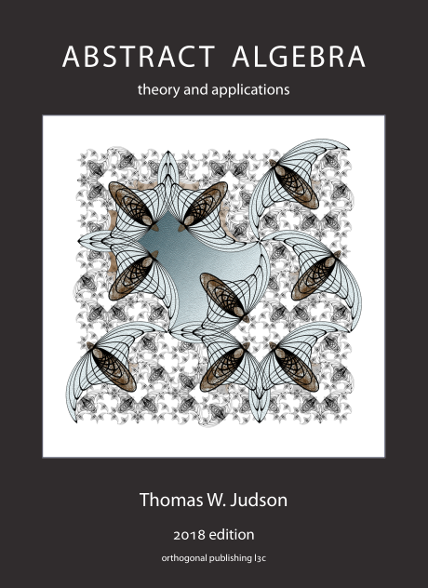Section 11.1 Cosets
Let \(G\) be a group and \(H\) a subgroup of \(G\text{.}\) Define a left coset of \(H\) with representative \(g \in G\) to be the set
\begin{equation*}
gH = \{ gh : h \in H \}.
\end{equation*}
Right cosets can be defined similarly by
\begin{equation*}
Hg = \{ hg : h \in H \}.
\end{equation*}
If left and right cosets coincide or if it is clear from the context to which type of coset that we are referring, we will use the word coset without specifying left or right.
Example 11.1.
Let \(H\) be the subgroup of \({\mathbb Z}_6^+\) consisting of the elements \(0\) and \(3\text{.}\) The cosets are
\begin{gather*}
0 + H = 3 + H = \{ 0, 3 \}\\
1 + H = 4 + H = \{ 1, 4 \}\\
2 + H = 5 + H = \{ 2, 5 \}.
\end{gather*}
We will always write the cosets of subgroups of \({\mathbb Z^+}\) and \({\mathbb Z}_n^+\) with the additive notation we have used for cosets here. In a commutative group, left and right cosets are always identical.
Example 11.2.
Let \(H = \{(1), (123), (132) \}\text{,}\) which is a subgroup of \(S_3\text{.}\) The left cosets of \(H\) are
\begin{gather*}
(1)H = (1 2 3)H = (132)H = \{(1), (1 23), (132) \}\\
(1 2)H = (1 3)H = (2 3)H = \{ (1 2), (1 3), (2 3) \}.
\end{gather*}
The right cosets of \(H\) are exactly the same as the left cosets:
\begin{gather*}
H(1) = H(1 2 3) = H(132) = \{(1), (1 23), (132) \}\\
H(1 2) = H(1 3) = H(2 3) = \{ (1 2), (1 3), (2 3) \}.
\end{gather*}
It is not always the case that a left coset is the same as a right coset. Let \(K\) be the subgroup of \(S_3\) defined by the permutations \(\{(1), (1 2)\}\text{.}\) Then the left cosets of \(K\) are
\begin{gather*}
(1)K = (1 2)K = \{(1), (1 2)\}\\
(1 3)K = (1 2 3)K = \{(1 3), (1 2 3)\}\\
(2 3)K = (1 3 2)K = \{(2 3), (1 3 2)\};
\end{gather*}
however, the right cosets of \(K\) are
\begin{gather*}
K(1) = K(1 2) = \{(1), (1 2)\}\\
K(1 3) = K(1 3 2) = \{(1 3), (1 3 2)\}\\
K(2 3) = K(1 2 3) = \{(2 3), (1 2 3)\}.
\end{gather*}
The following lemma is quite useful when dealing with cosets. (We leave its proof as an exercise.)
Lemma 11.3.
Let \(H\) be a subgroup of a group \(G\) and suppose that \(g_1, g_2 \in G\text{.}\) The following conditions are equivalent.
\(g_1 H = g_2 H\text{;}\)
\(H g_1^{-1} = H g_2^{-1}\text{;}\)
\(g_1 H \subset g_2 H\text{;}\)
\(g_2 \in g_1 H\text{;}\)
\(g_1^{-1} g_2 \in H\text{.}\)
In all of our examples the cosets of a subgroup \(H\) partition the larger group \(G\text{.}\) The following theorem proclaims that this will always be the case.
Theorem 11.4.
Let \(H\) be a subgroup of a group \(G\text{.}\) Then the left cosets of \(H\) in \(G\) partition \(G\text{.}\) That is, the group \(G\) is the disjoint union of the left cosets of \(H\) in \(G\text{.}\)
Proof.
Let
\(g_1 H\) and
\(g_2 H\) be two cosets of
\(H\) in
\(G\text{.}\) We must show that either
\(g_1 H \cap g_2 H = \emptyset\) or
\(g_1 H = g_2 H\text{.}\) Suppose that
\(g_1 H \cap g_2 H \neq \emptyset\) and
\(a \in g_1 H \cap g_2 H\text{.}\) Then by the definition of a left coset,
\(a = g_1 h_1 = g_2 h_2\) for some elements
\(h_1\) and
\(h_2\) in
\(H\text{.}\) Hence,
\(g_1 = g_2 h_2 h_1^{-1}\) or
\(g_1 \in g_2 H\text{.}\) By Lemma
11.3,
\(g_1 H = g_2 H\text{.}\)
Let \(G\) be a group and \(H\) be a subgroup of \(G\text{.}\) Define the index of \(H\) in \(G\) to be the number of left cosets of \(H\) in \(G\text{.}\) We will denote the index by \([G:H]\text{.}\)
Example 11.6.
Let \(G= {\mathbb Z}_6^+\) and \(H = \{ 0, 3 \}\text{.}\) Then \([G:H] = 3\text{.}\)
Example 11.7.
Suppose that \(G= S_3\text{,}\) \(H = \{ (1),(123), (132) \}\text{,}\) and \(K= \{ (1), (12) \}\text{.}\) Then \([G:H] = 2\) and \([G:K] = 3\text{.}\)
Theorem 11.8.
Let \(H\) be a subgroup of a group \(G\text{.}\) The number of left cosets of \(H\) in \(G\) is the same as the number of right cosets of \(H\) in \(G\text{.}\)
Proof.
Let
\({\mathcal L}_H\) and
\({\mathcal R}_H\) denote the set of left and right cosets of
\(H\) in
\(G\text{,}\) respectively. If we can define a bijective map
\(\phi : {\mathcal L}_H \rightarrow {\mathcal R}_H\text{,}\) then the theorem will be proved. If
\(gH \in {\mathcal L}_H\text{,}\) let
\(\phi( gH ) = Hg^{-1}\text{.}\) By Lemma
11.3, the map
\(\phi\) is well-defined; that is, if
\(g_1 H = g_2 H\text{,}\) then
\(H g_1^{-1} = H g_2^{-1}\text{.}\) To show that
\(\phi\) is one-to-one, suppose that
\begin{equation*}
H g_1^{-1} = \phi( g_1 H ) = \phi( g_2 H ) = H g_2^{-1}.
\end{equation*}
Again by Lemma
11.3,
\(g_1 H = g_2 H\text{.}\) The map
\(\phi\) is onto since
\(\phi(g^{-1} H ) = H g\text{.}\)

